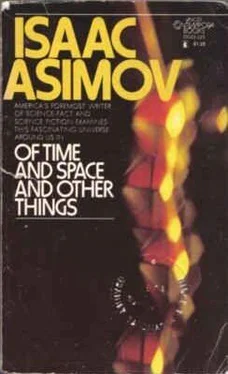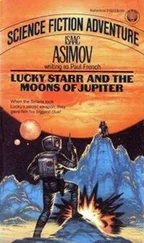Isaac Asimov - Of Time and Space and Other Things
Здесь есть возможность читать онлайн «Isaac Asimov - Of Time and Space and Other Things» весь текст электронной книги совершенно бесплатно (целиком полную версию без сокращений). В некоторых случаях можно слушать аудио, скачать через торрент в формате fb2 и присутствует краткое содержание. Год выпуска: 1972, ISBN: 1972, Издательство: Lancer Books, Жанр: Прочая научная литература, на английском языке. Описание произведения, (предисловие) а так же отзывы посетителей доступны на портале библиотеки ЛибКат.
- Название:Of Time and Space and Other Things
- Автор:
- Издательство:Lancer Books
- Жанр:
- Год:1972
- ISBN:ISBN: 0-447-33023-3
- Рейтинг книги:4 / 5. Голосов: 1
-
Избранное:Добавить в избранное
- Отзывы:
-
Ваша оценка:
- 80
- 1
- 2
- 3
- 4
- 5
Of Time and Space and Other Things: краткое содержание, описание и аннотация
Предлагаем к чтению аннотацию, описание, краткое содержание или предисловие (зависит от того, что написал сам автор книги «Of Time and Space and Other Things»). Если вы не нашли необходимую информацию о книге — напишите в комментариях, мы постараемся отыскать её.
Of Time and Space and Other Things — читать онлайн бесплатно полную книгу (весь текст) целиком
Ниже представлен текст книги, разбитый по страницам. Система сохранения места последней прочитанной страницы, позволяет с удобством читать онлайн бесплатно книгу «Of Time and Space and Other Things», без необходимости каждый раз заново искать на чём Вы остановились. Поставьте закладку, и сможете в любой момент перейти на страницу, на которой закончили чтение.
Интервал:
Закладка:
The inert gas is then tied to the substance and cannot be liberated without breaking down the molecule. However, the inert gas atom is only physically confined; it has not formed a chemical bond.
And yet, let's reason things out a bit. The boiling point of helium is 4.2' K.; that of neon is 27.20 K., that of argon 87.4' K., that of krypton 120.2' K., that of xenon 166.0' K. The boiling point of radon, the sixth and last inert gas and the one with the most massive atom, is 211.3- K. (-61.8- C.) Radon is not even a Gas, but merely a gas.
Furthermore, as the mass of the inert gas atoms in creases, the ionization potential (a quantity which meas ures the ease with which an electron can be removed alto gether from a particular atom) decreases. The increasing boiling point and decreasing ionization potential both indi cate that the inert gases become less inert as the mass of the individual atoms rises.
By this reasoning, radon would be the least inert of the inert gases and efforts to form compounds should concen trate upon it as offering the best chance. However, radon is a radioactive element with a half-life of less than four days, and is so excessively rare that it can be worked with only under extremely specialized conditions. The next best bet, then, is xenon. This is very rare, but it is available and it is, at least, stable.
Then, if xenon is to form a chemical bond, with what other atom might it be expected to react? Naturally, the most logical bet would be to choose the most reactive sub stance of all-fluorine or some fluorine-containing com pound. If xenon wouldn't react with that, it wouldn't react with anything.
(This may sound as though I am being terribly wise after the event, and I am. However, there are some who were legitimately wise. I am told that Linus Pauling rea soned thus in 1932, well before the event, and that a gentleman named A. von Antropoff did so in 1924.)
In 1962, Neil Bartlett and others at the University of British Columbia were working with a very unusual com pound, platinum hexafluoride (PtF6). To their surprise, they discovered that it was a particularly active compound.
Naturally, they wanted to see what it'could be made to do, and one of the thoughts that arose was that here might be something that could (just possibly) finally pin down an inert gas atom.
So Bartlett mixed the vapors of PtF6 with xenon and, to his astonishment, obtained a compound which seemed to be XePtFc,, xenon platinum hexafluoride. The announce ment of this result left a certain area of doubt, however.
Platinum hexafluoride was a sufficiently complex compound to make it just barely possible that it had formed a clath rate and trapped the xenon.
A group of chemists at Argonne National Laboratory in Chicago therefore tried the straight xenon-plus-fluorine experiment, heating one part of xenon with five parts of fluorine under pressure at 400' C. in a nickel container.
They obtained xenon tetrafluoride (XeF4), a straightfor ward compound of an inert gas, with no possibility of a clathrate. (To be sure, this experiment could have been tried years before, but it is no disgrace that it wasn't. Pure xenon is very hard to get and pure fluorine is very danger ous to handle, and no chemist could reasonably have been expected to undergo the expense and the risk for so slim-chanced a catch as an inert gas compound until after Bartlett's experiment had increased that "slim chance" tremendously.)
And once the Argonne results were announced, all Hades broke loose. It.looked as though every inorganic chemist in the world went gibbering into the inert gas field. A whole raft of xenon compounds, including not only XeF4, but also XeF., XeF6, XeOF2, XeOF3, XeOF4, XeO3, H4XeO4, and H,XeO,, have been reported.
Enough radon was scraped together to form radon tetra fluoride (RnF4). Even krypton, which is more inert than xenon, has been tamed, and krypton difluoride (KrF2) and krypton tetrafluoride (KrF4) have been formed.
The remaining three inert gases, argon, neon, and helium (in order of increasing inertness), as yet remain untouched.
They are the last of the bachelors, but the world of chemis try has the sound of wedding bells ringing in its ears, and it is a bad time for bachelors.
As an old (and cautious) married man, I can only say to this-no comment.
16. The Haste-Makers
When I first began writing about science for the general public-far back in medieval times-I coined a neat phrase about the activity of a "light-fingered magical catalyst."
My editor stiffened as he came across that phrase, but not with admiration (as had been my modestly confident expectation). He turned on me severely and said, "Nothing in science is magical. It may be puzzling, mysterious, in expbeable-but it is never magical."
It pained me, as you can well imagine, to have to learn a lesson from an editor, of all people, but the lesson seemed too good to miss and, with many a wry grimace, I learned
That left me, however, with the problem of describing the workings of a catalyst, without calling upon magical power for an explanation.
Thus, one of the first experiments conducted by any beginner in a high school chemistry laboratory is to pre pare oxygen by heating potassium chlorate. If it were only potassium chlorate he were heating, oxygen would be evolved but slowly and only at comparatively high temper atures. So he is instructed to add some manganese dioxide first. When he heats the mixture, oxygen comes off rapidly at comparatively low temperatures.
What does the manganese dioxide do? It contributes no oxygen. At the conclusion of the reaction it 'is all still there, unchanged. Its mere presence seems sufficient to hasten the evolution of oxygen. It is a haste-maker or, more properly, a catalyst.
And how can one explain influence by mere presence?
Is it a kind of molecular action at a distance, an extra sensory perception on the part of potassium chlorate that the influential aura of manganese dioxide is present? Is it telekinesis, a para-natural action at a distance on the part of the manganese dioxide? Is it, in short, magic?
Well, let's see…
To begin at the beginning, as I almost invariably do, the first and most famous catalyst in scientific history never existed.
The alchemists of old sought methods for turning base metals into gold. They failed, and so it seemed to them that some essential ingredient was missing in their recipes. The more imaginative among them conceived of a substance which, if added to the mixture they were heating (or what ever) would bring about the production of gold. A small quantity would suffice to produce a great deal of gold and it could be recovered and used again, no doubt.
No one had ever seen this substance but it was de scribed, for some reason, as a drv, earthy material. The ancient alchemists therefore called it xenon, from a Greek word meaning "dry."
In the eighth century the Arabs took over alchemy and called this gold-making catalyst "the xerion" or, in Arabic, at-iksir. When West Europeans finally learned Arabic alchemy in the thirteenth century, at-iksir became "elixir."
As a further tribute to its supposed dry, earthy prop erties, it was commonly called, in Europe, "the philos opber's stone." (Remember that as late as 1800, a "natural philosopher" was what we would now call a "scientist.")
The amazing elixir was bound to have other marvelous properties as well, and the notion arose that it was a cure for all diseases and might very well confer immortality.
Hence, alchemists began to speak of "the elixir of life."
For centuries, the philosopher's stone and/or the elixir of life was searched for but not found. Then, when finally a catalyst was found, it brought about the formation not of lovely, shiny gold, but messy, dangerous sulfuric acid.
Читать дальшеИнтервал:
Закладка:
Похожие книги на «Of Time and Space and Other Things»
Представляем Вашему вниманию похожие книги на «Of Time and Space and Other Things» списком для выбора. Мы отобрали схожую по названию и смыслу литературу в надежде предоставить читателям больше вариантов отыскать новые, интересные, ещё непрочитанные произведения.
Обсуждение, отзывы о книге «Of Time and Space and Other Things» и просто собственные мнения читателей. Оставьте ваши комментарии, напишите, что Вы думаете о произведении, его смысле или главных героях. Укажите что конкретно понравилось, а что нет, и почему Вы так считаете.












